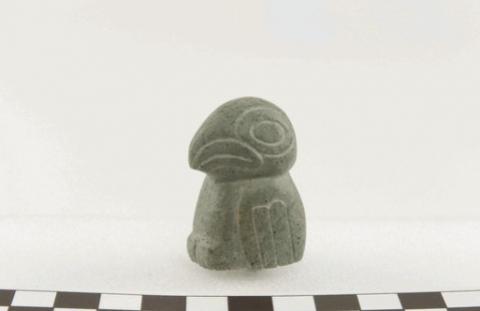Raven Serpentine Stone
This is a fairly small piece at 4.2cm or 1.65 inches. Serpentine Stone is one of three type of stones Tlingit artists used for art. It could be carved with woodworking tools. On the Mohs scale of hardness Serpentine Stone is a little harder than Soapstone. When working with this type of stone it is important that the dust produced be controlled because of its toxicity. Special techniques have to be implemented to minimize the risk when working with this material.
Yeil (Raven) is one of two moieties that make up the Tlingit nation. Each moiety is made up of clans and each clan is made up of houses and each house is made up of multigenerational family members and the clan is the most important component of the culture. So, the importance of the individual clan member is always secondary to the importance of the clan they belong to.
Balance is cultural value of major importance in Tlingit society, the two moieties Yeil (Raven) and Ch’áak (Eagle) could only marry each other. Raven to Eagle, or Eagle to Raven set up the matrilineal society that made up the Tlingit nation pre-European contact. You inherit everything from your mother’s clan, but you always honor your father’s clan and opposites.
Figure, carved green and black serpentine, of a raven with large eyes-consisting of a circle within a circle with carved details on wings and feet. Made by Amos Wallace.
Acquired by Indian Arts and Crafts Board representatives in 1962 when the artist was employed during IACB arts and crafts demonstrations at Juneau, Alaska; part of the IACB Headquarters collection (Department of the Interior, Washington, DC) until 2000 when it was transferred to NMAI.

